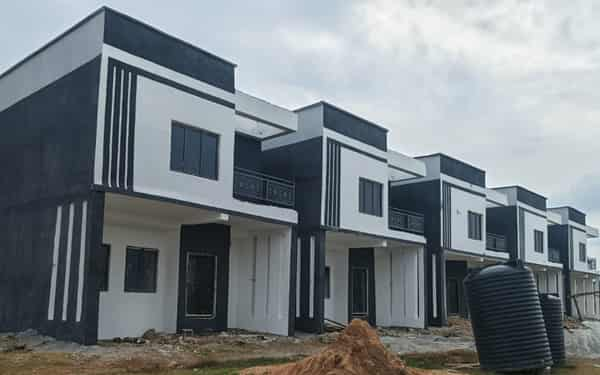Fundamental cost pressures and other microeconomic variables are forcing developers to increasingly focus on developing build-to-sell units in major city centres. Many developers consider the scheme as less risky, considering the opportunity it offers for reinvestments, VICTOR GBONEGUN reports.
As inflation eases, currency volatility and a shrinking pool of mortgage-ready buyers are prompting real estate developers to increasingly turn to the build-to-sell model as a survival strategy.
Once driven largely by long-term rental investments and off-plan sales, the market is witnessing a pronounced shift toward projects with quicker turnaround times. For many developers, this pivot is no longer optional; it has become a direct response to an unpredictable economic climate and the need to safeguard capital.
At the heart of the shift is a simple calculation that the longer money stays trapped in a project, the higher the risk. With construction costs fluctuating monthly and financing rates rising sharply, developers say it is no longer feasible to wait years to recoup investments through rent or long-term leases. Instead, many are opting to complete housing units and sell them immediately, a move they believe guarantees faster cash flow and a hedge against inflation.
Prices of essential construction materials have been among the strongest drivers of this trend, rising by over 100 per cent in some cases. Cement climbed to N13,000 per bag in 2024, granite held at N11,000 per tonne, while iron rods rose dramatically to N1.45 million per tonne. These cost surges have disrupted project timelines and budgets, forcing developers into a model that shifts long-term risk to buyers at the point of sale.
The emerging consensus across the sector is that the build-to-sell model, while logical from a business standpoint, could deepen Nigeria’s housing inequality if left unchecked. While developers navigate economic instability using quick-sale strategies, renters may face fewer options and higher prices. Without affordable financing, the dream of homeownership remains out of reach for millions.
Shifting buyer behaviour
Experts noted that this transformation is also being fuelled by changing buyer behaviour. With mortgage access weakening and households wary of long-term repayment commitments, more Nigerians, especially those with higher purchasing power, now prefer outright purchase of completed homes.
Developers have responded with flexible payment plans, often tailored to attract professionals, returning diaspora investors, and buyers seeking to hedge their wealth against naira instability. Investors, too, are gravitating toward completed units as a safer and more predictable asset class in a turbulent economy.
For developers, this convergence of demand has made build-to-sell not only a defensive adaptation but also a strategic advantage in an uncertain market. Yet the wider implications for affordability and housing availability remain deeply complex.
In the past three years, the real estate sector has grappled with intense volatility in the cost of building materials. This has resulted in frequent adjustments to property prices and, in many cases, renegotiation between buyers and developers before projects were completed.
Regulatory hurdles, high interest rates, unstable foreign exchange conditions, expensive land titling processes, reliance on imported building materials and persistent shortages in skilled labour have further compounded the challenges facing private investors. These factors have ultimately limited overall housing supply while narrowing profit margins for developers.
In high-demand markets such as Lagos, Abuja and Port Harcourt, build-to-sell units now dominate new residential offerings. Prices range between N250 million and N450 million for two-bedroom apartments, depending on finishing and facilities, while three-bedroom units and duplexes often exceed N600 million, sometimes quoted in foreign currencies. For one-bedroom apartments in prime areas, prices range from N35 million to N65 million.
According to industry insights, these properties are largely purchased by Nigerians in the diaspora and high-net-worth individuals seeking stable investment opportunities.
The dominance of build-to-sell, however, has introduced a new challenge, a glut of unoccupied buildings in city centres. In districts of Lagos and Abuja, completed luxury apartments remain empty for long periods as developers wait for the right buyers in a market where affordability has increasingly become a barrier. Meanwhile, rental accommodation has become scarce, leaving many home seekers struggling for access to quality and affordable housing.
The economics behind the trend
Managing Director of Propertyvault Limited, Andy Morka, explained that the economic trigger for the build-to-sell model rests squarely on the need for immediate yield and short turnaround times. Most developers, he said, lack access to long-term financing needed for multiple projects across different locations. A 12-month completion cycle has become ideal, allowing developers to quickly reinvest in new units.
But despite the appeal of faster returns, the strategy comes with pitfalls. “The demand for build-to-sell products is unpredictable,” Morka noted. “Sometimes projections do not materialise as expected. Any delay in sales ties down funds, slows down movement to new projects, and exposes developers to inflationary risks.”
To mitigate this, he said many developers now rely on off-plan sales, instalment payment plans, aggressive pre-launch campaigns, and extensive engagement with independent realtors who are incentivised to mobilise early subscriptions.
“With these measures and improved access to mortgage facilities, some developers achieve full subscription before project completion,” he said. “But the major implication is the high rental value of such properties, which is ultimately a reflection of the cost of acquisition.”
Buyers who acquire properties as investments often set rental rates high enough to recoup their capital, making such housing even less accessible to middle-income households.
Managing Director of Noble Ground Limited, Olajide Dosunmu, traced the rise of the build-to-sell model to shrinking rental yields. In the 1990s and early 2000s, developers could earn up to 10 per cent of property value annually through rent, making rentals attractive. But with today’s economic pressures, rising construction costs and lower disposable incomes, rental yields have dropped to between three and five per cent in key markets.
“Developers now find selling more profitable unless the property is located in extremely prime areas like Banana Island or Ikoyi,” Dosunmu explained. “Short-let apartments have become an alternative for homeowners seeking better returns in the current climate.”
He added that the affordability gap has created a market where buyers, many of them Nigerians living abroad, tend to absorb much of the supply. These buyers are often less concerned with immediate returns and more focused on long-term asset ownership. As a result, even though build-to-sell may dominate supply, many of those units eventually enter the rental market after being purchased by individual landlords.
Market structure and long-term risks
Professor of Building at the University of Lagos, Martin Dada, said the motivations behind build-to-sell are rooted in basic economics. Most private housing developers finance their projects with loans and therefore face the pressure of rising interest obligations. In such circumstances, he said, the need to recoup investment quickly becomes paramount.
“Every businessperson is focused on the bottom line,” Dada explained. “A developer must ask: If I rent this property, will I recoup costs within 10 to 15 years? Do we have tenants who can pay the true economic rent? When uncertainty dominates, selling becomes a way to reduce long-term risk.”
The challenge, he added, is that concentrating on build-to-sell does little to address the housing needs of lower-income households. “Developers are not in the business of social housing,” he said. “Unless they undertake it as corporate social responsibility, private developers follow market realities. This is why government intervention is necessary to provide social housing and safety nets for lower-income groups.”
Dada warned that reduced rental supply could worsen overcrowding, drive urban sprawl, and further strain infrastructure in fast-growing city centres.
An estate surveyor and valuer, and Council Member of the Nigerian Institution of Estate Surveyors and Valuers (NIESV), Prof. Austin Otegbulu, said high interest rates remain a major constraint on traditional build-to-lease investments.
With commercial loans often exceeding 25 per cent, he said, few residential or office properties can generate enough rental income to cover loan repayments and interest. “This is why most developers build to sell,” he explained. “Unless a developer can access cheaper financing, such as loans from the Federal Mortgage Bank, build-to-lease becomes impractical.”
He described developers who build to sell as ‘dealer developers,’ in contrast to “investor developers” who build specifically for long-term rental income. The current trend, he said, heavily favours the former due to profitability and the need for liquidity.
Otegbulu warned that the rise of the dealer-developer model means the space rental market is increasingly controlled by individuals who buy properties and later put them up for rent at their own terms. “The danger,” he argued, “is that properties are built but remain inaccessible to those who need them most. Developers are operating in the asset market, not the space market. The buyers dictate rental conditions, not the builders.”
He advocated for developers to explore capital-market-funded models such as Real Estate Investment Trusts (REITs), property bonds, securitisation and other financial instruments that offer cheaper and more sustainable project funding. This, he said, would encourage more build-to-rent developments and stabilise rental supply.






